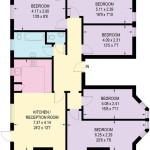Open Concept Bungalow Home Plans: A Guide to Spacious and Accessible Living
Open concept bungalow home plans represent a popular choice for homeowners seeking a blend of accessibility, spaciousness, and modern design. These plans combine the convenience of single-story living with the airy and interconnected feel of an open floor plan. This article explores the key features, advantages, design considerations, and common variations of open concept bungalow home plans.
The bungalow style, originating in India and later popularized in the West, is characterized by its low-profile silhouette, broad front porch, and emphasis on horizontal lines. When integrated with an open concept design, the bungalow’s inherent characteristics are enhanced, creating a home that feels both larger and more inviting.
Open concept design, as the name suggests, minimizes the use of walls to separate living spaces such as the living room, dining area, and kitchen. This creates a single, unified area that promotes interaction and maximizes natural light. In the context of a bungalow, this open flow can significantly enhance the home’s living experience.
Key Advantages of Open Concept Bungalow Home Plans
Open concept bungalow home plans offer several distinct advantages that make them appealing to a wide range of homeowners. These advantages can be categorized into factors related to accessibility, lifestyle, and design.
Firstly, the single-story nature of a bungalow eliminates the need for stairs, making it an ideal choice for individuals with mobility issues, families with young children, or those planning to age in place. This inherent accessibility is further enhanced by the open concept design, which allows for smooth and barrier-free movement throughout the main living areas.
Secondly, the open layout fosters a sense of spaciousness and connectivity. By removing dividing walls, natural light can penetrate deeper into the home, creating a brighter and more welcoming atmosphere. This design also promotes social interaction, allowing family members and guests to easily interact while engaging in different activities, such as cooking, relaxing, or dining.
Thirdly, open concept designs offer flexibility in terms of furniture arrangement and interior design. Without fixed walls dictating the layout, homeowners have greater freedom to customize the space to suit their individual needs and preferences. This adaptability is particularly valuable for those who enjoy entertaining or who anticipate changes in their lifestyle over time.
Essential Design Considerations for Open Concept Bungalows
While open concept bungalow home plans offer numerous benefits, careful planning and consideration are essential to ensure a successful design. Several factors should be addressed to achieve a harmonious and functional living space.
Zoning and Functionality: Even within an open space, it is important to define distinct zones for different activities. This can be achieved through the strategic placement of furniture, changes in flooring materials, or the use of partial walls or dividers. For example, a kitchen island can serve as a natural boundary between the cooking area and the dining area, while a rug can delineate the living room from the rest of the open space.
Acoustics and Noise Control: One common challenge of open concept designs is managing noise levels. Without walls to absorb sound, noise can easily travel throughout the space. Strategies to mitigate this issue include incorporating sound-absorbing materials such as carpets, curtains, and upholstered furniture. Additionally, strategically placing appliances and entertainment systems away from quieter areas can help minimize distractions.
Lighting and Ventilation: Adequate lighting is crucial for creating a comfortable and functional living space. In an open concept bungalow, it is important to consider both natural and artificial light sources. Large windows and skylights can maximize natural light, while strategically placed recessed lighting, pendant lights, and lamps can provide ample illumination during evenings and cloudy days. Proper ventilation is also essential to ensure air quality and prevent the buildup of odors, especially in the kitchen area.
Storage Solutions: Maintaining a clutter-free environment is essential in an open concept home. Adequate storage solutions are crucial to prevent belongings from accumulating in the living areas and disrupting the flow of the space. Built-in cabinets, shelving units, and strategically placed storage furniture can help keep items organized and out of sight. Consider incorporating storage solutions that blend seamlessly with the overall design aesthetic.
Privacy Considerations: While open concept designs prioritize connectivity, it is important to provide some level of privacy for bedrooms, bathrooms, and home offices. These spaces should be separated from the main living areas with solid walls and doors to ensure a sense of seclusion and tranquility. Consider incorporating features such as soundproofing and blackout curtains to further enhance privacy in these areas.
Common Variations in Open Concept Bungalow Plans
Open concept bungalow home plans come in a variety of styles and layouts to suit different preferences and lot sizes. Some common variations include:
The Ranch-Style Bungalow: This classic bungalow style is characterized by its long, low profile and sprawling layout. Ranch-style bungalows typically feature an open concept living area at the center of the home, with bedrooms and bathrooms located on either side. These plans often incorporate large windows and sliding doors to maximize natural light and provide access to outdoor living spaces.
The Craftsman Bungalow: This style emphasizes natural materials, handcrafted details, and a warm, inviting atmosphere. Craftsman bungalows often feature an open concept living area with exposed beams, hardwood floors, and a fireplace as a focal point. These plans tend to prioritize functionality and comfort over elaborate ornamentation.
The Modern Bungalow: This contemporary take on the bungalow style incorporates clean lines, minimalist design elements, and a focus on sustainability. Modern bungalows often feature open concept living areas with large windows, high ceilings, and energy-efficient appliances. These plans often incorporate smart home technology and sustainable building materials.
The Courtyard Bungalow: This variation features a central courtyard that serves as an outdoor extension of the living space. The open concept living area typically opens onto the courtyard through large sliding doors, creating a seamless transition between indoor and outdoor living. Courtyard bungalows offer enhanced privacy and a tranquil retreat from the outside world.
The L-Shaped Bungalow: This layout features two wings that meet at a right angle, forming an "L" shape. The open concept living area is typically located at the intersection of the two wings, providing views of both the front and back yards. L-shaped bungalows offer a flexible layout that can be adapted to various lot sizes and orientations.
Consideration should also be given to the orientation of the bungalow on the lot. Optimizing the positioning of windows to capture sunlight during the day and considering prevailing wind patterns for natural ventilation can significantly impact the energy efficiency and comfort of the home.
The selection of materials plays a crucial role in enhancing the aesthetics and functionality of an open concept bungalow. Durable and low-maintenance materials are often preferred, especially for flooring and countertops. The use of natural materials such as wood, stone, and brick can add warmth and character to the space.
Ultimately, the ideal open concept bungalow home plan is one that reflects the homeowner’s individual needs, preferences, and lifestyle. Careful planning, thoughtful design, and attention to detail are essential to create a home that is both beautiful and functional, providing a comfortable and enjoyable living experience for years to come.
Navigating local building codes and regulations is an important aspect of planning any home. Ensure that the chosen design complies with all applicable codes related to structural integrity, fire safety, and accessibility. Consulting with experienced architects and builders is recommended to ensure a smooth and successful construction process.
Landscaping also plays a role in complementing the bungalow style. A well-designed landscape can enhance the curb appeal of the home and create a more inviting outdoor living space. Consider incorporating features such as native plants, outdoor lighting, and comfortable seating areas to maximize the enjoyment of the surrounding environment.

Free Editable Open Floor Plans Edrawmax

10 Small House Plans With Open Floor Blog Homeplans Com

Open Concept Ranch Floor Plans Houseplans Blog Com

Open Floor Plans Creating A Breathable Livable Custom Home Builders Schumacher Homes
:max_bytes(150000):strip_icc()/1660-Union-Church-Rd-Watkinsville-Ga-Real-Estate-Photography-Mouve-Media-Web-9-77b64e3a6fde4361833f0234ba491e29.jpg?strip=all)
18 Open Floor House Plans Built For Entertaining

House Design Trends What S Popular In Cur Floor Plans Extra Space Storage

Classic House Plans Open Concept Floor

30 Gorgeous Open Floor Plan Ideas How To Design Concept Spaces

Open Floor Plans Build A Home With Smart Layout Blog Dreamhomesource Com

3 Bedroom One Story Open Concept Home Plan Architectural Designs 790029glv House Plans








